HenryGate

A group of Chinese tourists I noticed yesterday contemplating the Great Gate of Trinity College — and no doubt wondering who is the cove in the alcove half-way up the structure. He is none other than Henry VIII, who, taking time off from murdering his wives, founded the college. The sculpture originally showed him holding a sceptre in his right hand and an orb in his left, but it now shows him wielding a different symbol of power — a chair leg!
There wqs a nice story about this in the Cambridge News some years ago. Apparently in the 1980s a cleaner working on the windows next to the statue noticed that the sceptre had gone missing and replaced it with a leg from a broken chair on the landing inside the tower. You may think (as I did) that the story is too good to be true. I tried zooming in on the image, but Henry became too pixelated, and so I went looking for a higher-resolution pic and found this one in a 2023 BBC report.

Quote of the Day
”A parrot trained to repeat the phrases “orange man bad”, “brexit bad” and “crypto scam” has outperformed 99.9% of professional analysis over the last decade.”
- Alex Hern
Musical alternative to the morning’s radio news
Richard Strauss | Four last songs | Im Abendrot | Kiri Te Kanawa
I love these songs and keep coming back to them.
Long Read of the Day
LLMs are not a Flawed Design, they are the Completion of a Flawed Paradigm
This essay by Erik J Larsen is one of the most astute pieces I’ve read on the Large Language Models (LLMs) that the tech industry (and most of the media) persist in describing as ‘artificial intelligences’ or ‘AIs’. They are a product of a powerful technology called machine learning (ML), the developments in which have been truly astonishing. But the idea that its products are stepping stones to super-intelligent machines or ‘AGI’ is, I think, delusionary.
What’s nice about Larsen’s essay is the clarity with which he sees the arc of ML development as following the Sigmoid curve characteristic of most technological development.
Here’s a sample:
This phase of machine learning, now nearing an apex, WILL START TO COME TO AN END, only to—if history is any guide—give rise to new and as yet unknown innovations. Critique all you want. But get the bigger picture, too.
Not Heading To AGI
I could not have hoped for a better trajectory for machine learning than the end game of large language models… We’re not close to AGI. We’re further away. But we couldn’t see it before, and so speculation and futurism ran wild.
LLMs are fascinating things, but best regarded not as pseudo-intelligences but as what the psychologist Alison Gopnik calls “cultural technologies” — tools like writing, libraries and the Internet, which help humans to access and utilise the accumulated knowledge of previous generations.
Hope you enjoy the essay as much as I did.
Books, etc.

I enjoyed the book and reviewed this for the Observer on Sunday.
The enduring mystery about William Henry Gates III is this: how did a precocious and sometimes obnoxious kid evolve into a billionaire tech lord and then into an elder statesman and philanthropist? This book gives us only the first part of the story, tracing Gates’s evolution from birth in 1955 to the founding of Microsoft in 1975. For the next part of the story, we will just have to wait for the sequel.
In a way, the volume’s title describes it well. In the era before machine learning and AI, when computer programs were exclusively written by humans, the term “source code” meant something. It described computer programs that could be read – and understood, if you knew the programming language – enabling you to explain why the machine did what it did.
So what can we learn from inspecting Gates’s code? Broadly speaking, the message is that he was a very lucky lad. He was born in the right place at the right time to parents who gave him, he writes, “the precise blend of support and pressure I needed: they gave me room to grow emotionally, and they created opportunities for me to develop my social skills”. His account suggests, though, that it was an uphill battle at times. Bill Snr and Mary Gates discovered that they had a boy who was a strange blend of high IQ, arrogance, rebelliousness and insecurity…
My commonplace booklet
Price matching Lidl
Nice blast by Jonty Bloom:
Lidl has got the perfect response to other supermarkets who claim to be price matching them “there is only one place where all the prices are matched with Lidl’s, Lidl”.
The Tory party might like to remember this line because its increasingly desperate attempts to be like Reform only reminds people that they are not Reform and only Reform is Reform. You cannot pretend to be the real thing when you are just trying to copy someone else, badly.
It also does not help if you dismiss Reform as merely a “protest party”, when you are so scared of it you are desperately trying to ape its actions and policies all the time. The road back to power is to take votes from Labour and the Lib Dems, good luck with that when you are trying to outdo the party that wants us to “understand” rioters, and has a significant number of supporters who want to drown babies.
Interesting thought. Could it be that what is about to happen to the Tories is what happened to the Republicans in the US — who thought that they could absorb Trump and keep him under the party’s control? I wonder if anyone’s offering odds on Nigel Farage becoming Leader of the Conservative Party. You think I jest? At one stage — not so long ago — the odds of Jeremy Corbyn becoming Leader of the Labour Party were 1000 to one. I was too stupid to take the bet. Sigh.
This Blog is also available as an email three days a week. If you think that might suit you better, why not subscribe? One email on Mondays, Wednesdays and Fridays delivered to your inbox at 6am UK time. It’s free, and you can always unsubscribe if you conclude your inbox is full enough already!
